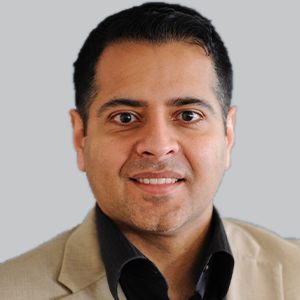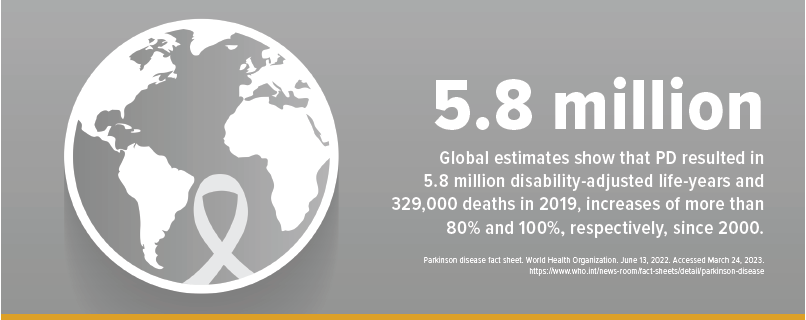GUEST EDITOR IN CHIEF
Laxman Bahroo, DO, FAAN, attended Rutgers University for his undergraduate studies and University of Medicine and Dentistry for graduate study, both in New Brunswick, New Jersey. He completed his internship at Saint Luke’s Hospital in Bethlehem, Pennsylvania, and both a neurology residency and fellowship in movement disorders at Medstar Georgetown University Hospital. As a movement disorders specialist, he manages an active clinic focusing on medical and surgical treatment of Parkinson disease and essential tremor. He specializes in the therapeutic role of botulinum toxin injections for dystonia, spasticity, and sialorrhea. He lectures at regional, national, and international conferences and has published papers in various medical journals.
AS I REFLECT ON major trends in the management of Parkinson disease (PD), I consider that early treatment of patients focused on anticholinergics. With the discovery of the loss of dopamine in PD in the 1950s, the dopaminergic era ensued, and from the 1960s to 2010s, various dopaminergic and adjunct treatments emerged. In 2015, we were ushered into an era of longer-acting medications delivered orally or via a pump directly into the gastrointestinal (GI) tract. Over the past 8 years, patients have benefited from newer therapies, ranging from extended-release formulations to novel targeting agents. Longer-acting therapies provide better control of motor symptoms, reduce OFF time, and decrease pill burden. These therapies have increased the options for managing motor complications. Despite this, treating patients with motor fluctuations remains a major unmet need.
A unique class of medications, aptly called “on-demand” therapies, are given at the times of unpredictable and variable OFF. This class consists of dopamine agonists and levodopa delivered differently to manage OFF episodes caused by GI variability, which often results in dosing delays, treatment failures, suboptimal ON time, and early termination of treatment. GI-based OFF episodes are both common and underrecognized. On-demand therapies, though, bypass the GI tract and provide quicker onset to reduce the interruption caused by OFF episodes. Despite several options—orally inhaled levodopa, apomorphine via sublingual and subcutaneous routes—on-demand therapy use is limited. Educating providers on the role of the GI system in OFF episodes is as essential as educating patients and caregivers on proactive use of on-demand medications to quickly manage OFF episodes.
Awareness of common nonmotor symptoms is as important as understanding motor symptoms. Nonmotor symptoms such as neurogenic orthostatic hypotension, sialorrhea, depression, dementia, and psychosis are more bothersome than motor symptoms. Nonmotor symptoms affect patient and caregiver quality of life. PD psychosis is common, with up to 50% prevalence among patients, and it is one of the most disturbing nonmotor symptoms for patients and caregivers. Symptoms can begin insidiously and for a variety of reasons that often go undiscussed with providers. Over the course of time, hallucinations and delusions progress and result in loss of insight. Conventional treatment of psychosis blocks dopamine and poses a challenge for patients with PD because it can worsen motor symptoms. Treatment with a serotonin 2A inverse agonist such as pimavanserin (Nuplazid; Acadia Pharmaceuticals) reduces the frequency and severity of hallucinations without worsening motor symptoms.
As we look to the future of PD therapeutics, I see 2 trends emerging. The first is newer therapies that provide even longer-acting medications via unique mechanisms such as mucoadhesion and subcutaneous delivery of levodopa or apomorphine. Subcutaneous delivery provides an exciting intermediate (nonsurgical) option for continuous delivery of medications throughout the day and potentially 24 hours. It can significantly reduce OFF time, similar to what is currently achievable with surgical therapy. A parallel trend includes selective dopaminergic agents with potentially better adverse effect profiles and new agents for dyskinesia and tremor.
Beyond managing motor function is targeting the underlying pathology in PD. The holy grail of neurodegenerative disorders would be to alter or halt the progression of disease. For years, discussion has swirled around stem cells and gene therapy, and they remain potential options for the future. Several therapeutic agents have emerged focusing on α-synuclein misfolding and aggregation. A repurposing of existing immunomodulators, tyrosine kinase inhibitors, and GLP-1 has emerged. α-Synuclein antibodies and a focus on mitochondrial dysfunction are other newer areas of interest. Across these therapeutic options, trials are ongoing with results eagerly awaited by the community. Overall, the field of disease modification looks promising with a mix of existing therapies repurposed and novel agents and targets.
This issue contains more in-depth articles on each of the topics above, providing you with current information on the practical topics in the management of PD. Furthermore, you can apply the knowledge to improve patient care and education.







